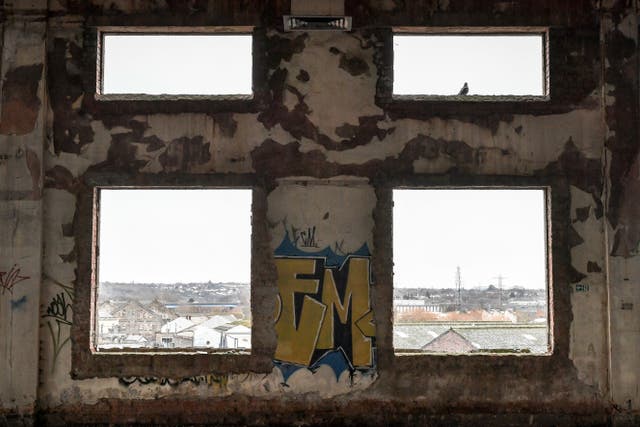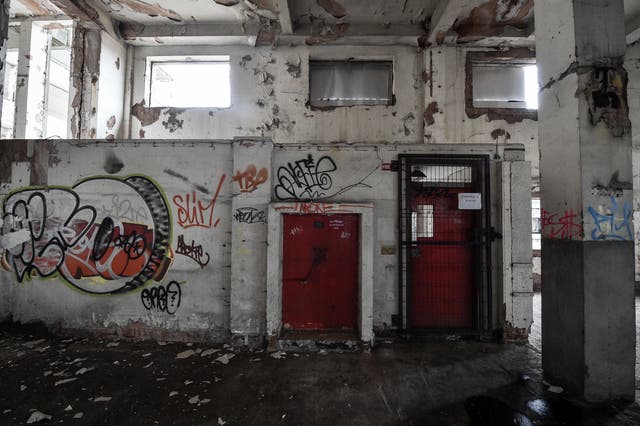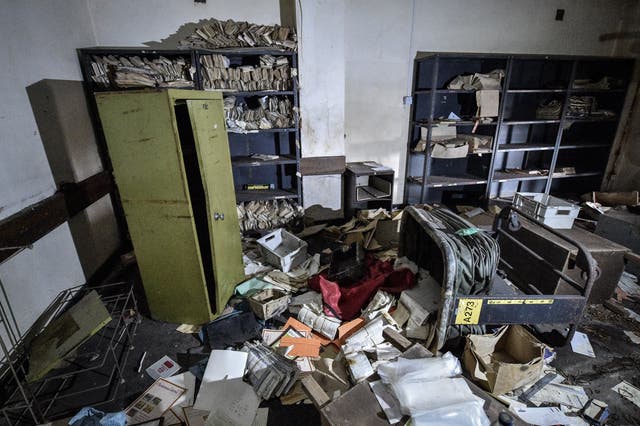
Demolition work has begun at Bristol’s most famous eyesore, bringing an end to a building that became a playground for squatters, illegal ravers and fledgling graffiti artists.
The former Royal Mail sorting office, next to Bristol Temple Meads railway station, lay derelict from 1997 and is now being destroyed to make way for a new university campus.
Heavy machinery began “nibbling” at the structure on Wednesday afternoon, after Bristol mayor Marvin Rees shouted “Let the demolition commence” into a loud speaker.
Drone footage taken on Tuesday reveals the exterior and interior of the site, reportedly described by former prime minister David Cameron as like an “entrance to a warzone”, before demolition started.
Graffiti covers swathes of the grey building, while a safe room reveals Royal Mail boxes, bundles of yellowing paperwork and flyers advertising stamp sets from 1986.
Writer Vanessa Kisuule described the building as “a place of honest work, a den of deviant pleasures” in a poem released to mark the start of the demolition.
The poem, Brick Me, calls the site “a chipped tooth in Bristol’s smile”.
Professor Hugh Brady, vice chancellor and president of the university, said: “The start of demolition is a major historical milestone for both the university and the city.
“The campus will help transform this previously neglected area into a vibrant new quarter of the city, which will benefit everyone.
“The campus offers an opportunity to connect with our communities in new ways, offering new public spaces, facilities and educational opportunities.
“We’re looking forward to working with businesses, government, local organisations and communities as plans for the campus take shape.”

The seven-acre site has been home to a sorting office, a cattle market and a colour works factory, exporting carpets and floor cloths around the world, as well as a cholera burial ground in the 1830s.
John Hare and Co, the oldest British company to manufacture floor cloths, was established in 1782 and based on the site.
Around 400 people were employed by the firm in the mid-19th century, producing up to 5,000 square yards of cloth each week and exporting to five continents.
In 1830, the city centre’s cattle market moved to the site and was operational until the 1960s.

Cattle, sheep, pigs, calves and horses were shipped in from as far afield as Canada, with stories from that time including bulls breaking free and running down the streets.
In 1938, the Station Sorting Office was formally opened by the mayor of Bristol who pressed a button to start the machinery of the conveyor belts.
In the 1950s, the office received around 75,000 items each week.
A new administration block was opened in 1972, with further development in the late 1970s.
Royal Mail moved its sorting office to Filton in 1997 and the site became known for illegal raves, urban explorers and graffiti.
In 2015, the site was acquired by Bristol City Council.

Mr Rees said: “This eyesore building has been a blight on the landscape for too long, its demolition will be the start of a new chapter for the area.
“The redevelopment of the Temple Quarter will help deliver the gateway the city deserves, as well as regenerating the area with thousands of new homes and jobs.
“As well as creating a brand new university campus, the clearance of this site will unlock new routes to the station and open up vital links between the east of Bristol and the centre.”

Contractors Kier stripped out the building and prepared the site before using heavy machinery to demolish the 1930s sorting office and adjoining 1970s administration building.
The campus, which is set to open in 2022, will span both the plot and part of neighbouring Temple Island.
It will provide teaching, research and innovation space for 800 staff, external partners and 3,000 students, with accommodation on site for up to 1,500 undergraduates and postgraduates.


Comments: Our rules
We want our comments to be a lively and valuable part of our community - a place where readers can debate and engage with the most important local issues. The ability to comment on our stories is a privilege, not a right, however, and that privilege may be withdrawn if it is abused or misused.
Please report any comments that break our rules.
Read the rules here